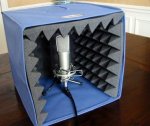spantini
COO of me, inc.
The bass traps may not do what you need them to do. This post is well worth reading, as you are the only one who really knows your environment. It was written by John Brandt. John is known world wide for his work in studio design concerning sound waves/rays and treatments. He's a member here and he wrote a great post for this community. He also has some great videos for treating small rooms. Have a great weekend! p.s. What do you call a guitar player knocking at your door?
 Hard science.. Love it! Thank you!
Hard science.. Love it! Thank you!Following this advice fully is not feasible in my apartment. I can hang (removable) panels on all my walls, but the ceiling is out of bounds as any fixtures required to affix panels there are not permitted. Maybe I can construct an artificial, collapsible lowered ceiling. Or.. possibly a collapsible room-within-a room - like a large closet.








